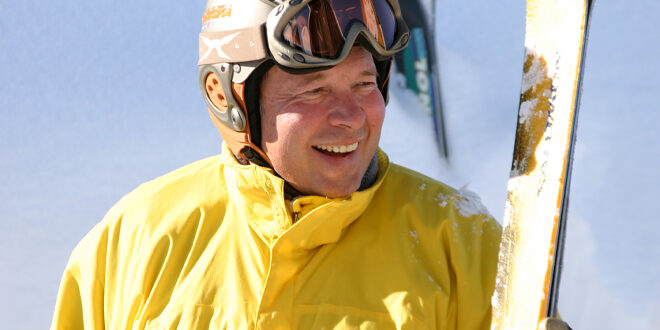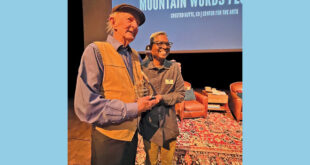A life well skied…
By Dawne Belloise
Longtime local and mountain enthusiast John Norton will soon be immortalized by the Colorado Snowsports Museum and Hall of Fame as they induct him for his lifelong career contributions to the industry in Crested Butte and Aspen at the end of August.
Adding his name to the great legends including Crested Butte’s Al Johnson, Ralph Walton and Dick Eflin, as well as Aspen’s Walter Paepcke, Friedl Pfeifer and Fred and Elli Iselin, the organization will recognize Norton’s dedication to marketing programs, special events, terrain expansion, community alliance-building and the guest experience. He is being inducted as a ski industry innovator in the Sports Builder category.
Crash landing!
Norton landed in Crested Butte in July of 1985 from New York City after spending his career in marketing with Procter and Gamble. He recalls, “Every time the company wanted to move me, I asked about Denver. I loved the mountains,” and when he figured out that relocation wasn’t going to happen through his company, he set out to find his own way to the mountains. Back then, Crested Butte Mountain Resort (CBMR) owners Edward Callaway and Ralph Walton had been looking within the ski industry for a marketing vice president but couldn’t find one. It was Callaway, whom Norton had known from Dartmouth College who suggested Norton as a candidate for the job even though he didn’t have any ski industry experience. Norton and his wife Robin decided to head west and check it out first.
They arrived in April 1985 after the lifts had closed. They had never skied the mountain, which was enshrouded in clouds the entire day-and-a-half they were here. There were no restaurants open for breakfast, lunch or dinner. “We had cloud cover the whole time so we couldn’t see the mountain but it looked decent from the trail maps so I decided to accept the offer.” The first time they actually saw Crested Butte Mountain was in July when they moved here. “I thought it was so beautiful, the whole valley. I was in awe driving up.” In fact, he was in such awe of the scenery that he totaled the company Subaru. They were fine but Norton laughs, “That was day one.”
Fill the airline seats
CBMR had just signed a contract with American Airlines to guarantee the airline revenue for flights to Gunnison from four major cities. “They were betting the company and needed to make sure the program was going to work,” he recalls. Walton, one of the owners of CBMR at the time, had told him that Crested Butte was very well known and people were dying to come, but the valley didn’t have the airline service. “But that was of course a lie. No one had heard of Crested Butte, and no one was dying to come here,” he laughs.
The CBMR airline program that paid to guarantee airline flights to come to the airport was the first in the industry. It began in 1985 and Norton says that Steamboat and Jackson Hole followed CB’s lead in their 1986/87 season and Vail did the same in 1987/88. “The first year was miserable,” Norton remembers. “By January, we had cut the Houston and Los Angeles service completely and moved Chicago to weekends only. Dallas was laboring but we were able to fix that by the end of the year.” He notes that the route then became successful.
Ski free?
Many remember and took advantage of CBMR’s out-of-the-box “Ski Free” promotion, and you have John Norton to thank for those days when lift tickets cost absolutely nothing. But given CB’s location most people had to come and stay for a few days so money was spent. It was an ingenious plan to bolster revenue for the late November, early December part of the ski seasons that normally was dead. He had conjured to solve an early season attendance problem.
“We would open and lose money between Thanksgiving and Christmas. There weren’t any flights and no one was here.” So Norton pitched the idea to his CBMR bosses of a delayed opening until Christmas, explaining that they’d not only save money but could then use those saved funds for ski patrol and to open the extreme terrain early. Callaway promptly nixed Norton’s idea and reminded Norton that his job was to figure out how to make money in that dead season.
But Norton thought, “To get people here, then we have to practically give skiing away, but if we’re giving it away how do we make money? Everybody was going broke,” he says of the slump season. “I went to the hotel people in the valley and asked if they’d give us $20 a night (from their bookings) if we had free skiing.” Then he solicited restaurants and retailers for 10% of their increase. At the time, he was on the CB town council, so he recused himself when he also requested 10% of the sales tax increase. Every sector, from council to businesses, unanimously agreed to contribute to the Free Ski concept. They started the campaign in 1991 and, through various iterations, it went on for nine years and was a tremendous success. “Everybody made money,” he says of the popular program.
Extreme lifts!
It was Norton who argued for the North Face and High Lift installations. He recalls Ralph Walton growing weary of hearing him preach about both lifts, and suggested that Norton essentially put his money where his mouth was. “Ralph said to me, if you want a North Face lift so badly, buy it out of your marketing budget.” Walton figured that would be the end of it, but the wheels started spinning in Norton’s head. “I went back to my office and thought about it, and you know what, I felt it was worth doing.”
Norton had a chat with mountain operations to see how much the lift would cost. “It was about $550,000 for the original Poma that we could buy used from Ski Broadmoor, which had gone defunct.” Then he told Walton that the marketing department would buy the lift and install it. “Ralph was in shock. He was thinking that there’d be no marketing budget for a year,” but Norton convinced him that not only would it be okay, but they’d make a lot more money. The lift was installed in 1988. “And that’s why we have a North Face Lift,” he grins. “The North Face worked out so well that we started talking about the High Lift, but marketing didn’t have to pay for that one. No one had lifts into extreme terrain back then. It was completely novel.”
When the press caught wind of the endeavor, Norton recalls “We were absolutely assaulted by the ski media press who thought we were doing something that was incredibly irresponsible and leading to all sorts of carnage. Bob Gillen, who was running our PR, told Ski Magazine that we didn’t expect to be carrying a bunch of skiers off the hill in body bags. The patrol had a lot of fun with that quote and that’s where the name for the run Body Bag came from on the North Face. There’s another run named Dead Bob’s. Both came from Bob’s PR efforts.”
More… and a move
Norton continually pressed for terrain expansions and lift upgrades, but the ownership of CBMR didn’t want to spend the money to do any of it. “Aspen was doing great at that time, and still is, and I wanted to go work for someone who wanted to win,” he says. He and Robin left Crested Butte for Aspen in 1991. “It was a terrific move. I was certainly heartbroken to leave this community, but Aspen is a terrific community as well. We had major expansions on all four mountains and were installing one or two lifts a year while I was there.” Norton was instrumental, arguably the sole individual, who convinced the Aspen Ski Corporation to lift the ban on snowboards. “Our customers, our skiers, were getting old and not allowing snowboards is kind of sending a signal to younger people that we really don’t like you.” He successfully argued that they needed the next generation. So boarders have Norton to thank for opening the Aspen slopes to them. Norton adds, “The ownership was great. The company was populated with a bunch of wonderful people. I treasured my 11 years in Aspen.”
In 2002, as Norton was entertaining the idea of change to a different ski complex, Edward Callaway asked him to return to CB because “This is where your heart is and the company is all yours,” Norton recalls the conversation. “We were driving over Kebler and had not made up our minds yet but when we came around the curve where you can see Crested Butte Mountain, my wife said, ‘We can’t go anywhere else. Let’s go home to CB.’” Norton returned as CEO of CBMR in 2002.
Norton hadn’t realized the financial difficulties the company had encountered in his years away. “It was pretty clear to me and Edward that I needed to turn the company way around in terms of revenues in two years or sell the company.” They ended up selling the company to the Mueller family in 2004. Norton stayed through the fall of that year and continued as a consultant for seven years. He resigned in 2008 because, by then, he was also CEO of a Boulder company and commuting a week at a time and traveling.
In 2014, he formed his own company, Norton Global, a consulting business that works on and fixes cultural issues inside companies.
These days, Norton runs the area’s Tourism and Prosperity Partnership (TAPP) in the Gunnison Valley as its executive director. “I was asked to step in on a temporary basis in 2016, and then the new board asked me to stay on,” he says. “We do sustainable tourism, and all the trailhead kiosks around the valley. We also do economic development and we help to grow entrepreneurs in the valley.” The ICELab at Western Colorado University is part of TAPP.
Norton has had a ski pass every year since 1985 and clocked in 80 days on the slopes last season. It’s not surprising that Norton feels quite honored to join the likes of the 10th Mountain Division and so many great athletes and ski area founders in the Colorado Snowsports Hall of Fame. “It’s something really special and a humbling experience,” he says. “I really, really loved being in the ski business and this is icing on the cake.”
The Hall of Fame induction celebration will take place on Sunday, August 27 at the Gerald Ford Amphitheater in Vail. Tickets start at $50, and the event is open to the public and is family friendly.
 The Crested Butte News Serving the Gunnison Valley since 1999
The Crested Butte News Serving the Gunnison Valley since 1999





